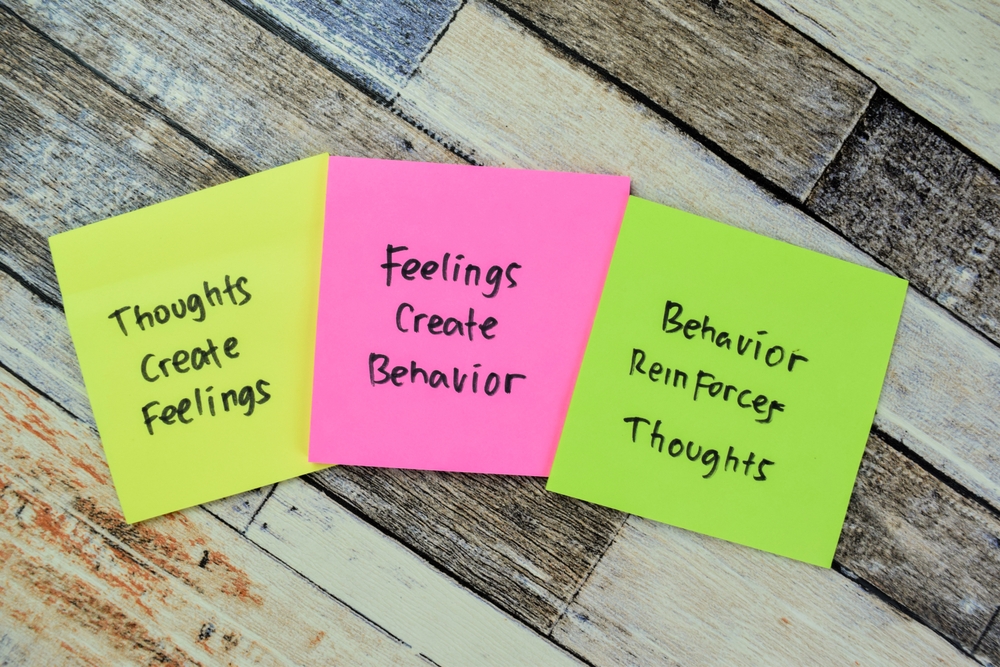Self-CBT is free, independent, and just as useful as normal therapy…
‘I am never good enough for them…’
Our brains are naturally thought-processing machines. They create and manage as many as 60,000 ideas in a given day. That is… an overwhelming flood of information.
Struggling with persistent negative thoughts can feel overwhelming, but you don’t need to face them alone—or even pay for therapy to start making progress. These thoughts are common in depression, anxiety, and most other mental health conditions.
Self-guided Cognitive Behavioral Therapy (CBT) is a powerful, evidence-based approach that can help you recognize and challenge unhelpful thinking patterns on your own. By learning to identify distorted thoughts and replace them with more balanced, realistic ones, you can begin to break the cycle of anxiety, depression, or self-doubt.
This guide offers a practical, step-by-step introduction to using self-CBT techniques to take control of your mental well-being—starting with identifying those hidden negative thoughts.
What are negative automatic thoughts (NATs)?
In psychological terminology, negative automatic thoughts, or NATs, represent thought distortions that do not fit what is really going on. These puzzling thoughts are often confused for emotions. However, feeling that something bad is going to happen is a thought! And in most cases, it will not be useful for processing the reality as it truly is.
Here are some nuanced examples of NATs that can arise and should be identified before they dictate faulty behavior:
- Nothing good ever happens to me.
- People probably think I’m boring.
- I always attract the wrong kind of partner.
- I ruin everything.
- He’s just a selfish person.
- I’m not qualified enough to get hired anywhere decent.
- They only gave me that opportunity out of pity.
- I should be trying harder—what’s wrong with me?
These examples reflect common thinking traps such as catastrophizing, personalization, overgeneralization, and labeling, all of which self-CBT helps you recognize and reframe. Shall we get into it and challenge them?
Scroll down to read more about Free Therapy: Identify Negative Thoughts With Self-CBT…

Situation -> NAT -> Emotions -> Behavior
Did you know that CBT is the most used therapy method in the world? Specialists say it is indeed the most useful in tackling pretty much any mental health condition. It’s also used to help with sleep problems, chronic pain, procrastination, low self-esteem, and even sports performance! Practicing self-CBT can empower you, not just soothe your pain.
Awareness begins with education. So, here is a concise list of the most common CBT-inspired cognitive distortions, also known as NATs. Do you have any of them?
- All-or-Nothing Thinking (Black-and-White Thinking)
Seeing situations in extremes—everything is either a total success or a complete failure.
Example: “If I’m not perfect, I’m a failure.” - Overgeneralization
Making broad conclusions based on one event or limited evidence.
Example: “I got rejected once—nobody will ever want me.” - Mental Filtering
Focusing only on the negative parts of a situation, ignoring any positives.
Example: “Everyone complimented me except one person—so I must have done terribly.” - Discounting the Positive
Dismissing good things as luck, mistakes, or meaningless.
Example: “That compliment doesn’t count—they were just being nice.” - Jumping to Conclusions
Assuming you know what others are thinking or what will happen—without evidence.Mind Reading: “She didn’t text back, so she must be mad at me.”Fortune Telling: “I’m going to mess this up.” - Catastrophizing
Expecting the worst possible outcome, even if it’s unlikely.
Example: “If I make a mistake, I’ll get fired and never find another job.” - Emotional Reasoning
Believing something is true because you feel it strongly.
Example: “I feel useless, so I must be useless.” - “Should” Statements
Setting rigid rules for yourself or others, leading to guilt or frustration.
Example: “I should always be productive.” - Labeling
Assigning a fixed, negative label to yourself or others.
Example: “I’m a loser” or “He’s a jerk.” - Personalization
Blaming yourself for things outside your control or taking things too personally.
Example: “It’s my fault they’re upset—I must have done something wrong.”
If you are committed to your healing, take a proactive step towards better mental health and note these down.
After you do that, take for instance the following therapist-backed exercises you can do at home today. Consistency and active work are all you need to start healing yourself. It is free of cost, accessible from anywhere, and available 24/7.
Feel free to research other methods of self-CBT as well. Some of them could even be tailored to your specific needs and wants.
1. Thought Record (Daily Log)
Purpose: Track and analyze your automatic thoughts.
Instructions: At the end of each day (or after a stressful situation), write down:
- The situation (what happened)
- The emotion you felt (and its intensity)
- The automatic thought(s) that came up
- Evidence for and against that thought
- A more balanced alternative thought
- Your new emotion (and its intensity)
2. Catch, Challenge, Change
Purpose: Create awareness and restructure distorted thoughts in the moment.
Catch the thought: Notice when your mood suddenly drops or anxiety spikes.
Challenge it: Ask yourself questions like:
- Is this thought 100% true?
- What’s the evidence?
- What would I say to a friend in this situation?
Bottom line is, your worry does probably not resemble reality. So, change it. Replace it with a more realistic, compassionate thought.
3. The “What If…Then What?” Drill
Purpose: Reduce catastrophic thinking.
Write down your fear in a “what if” form (e.g., What if I fail this presentation?)
Answer: Then what would happen?
Keep going until you reach the “worst-case scenario”—and then ask: How would I cope with that? This helps build resilience and puts fears in perspective.
Scroll down to read more about Free Therapy: Identify Negative Thoughts With Self-CBT…

4. Evidence Table
Purpose: Challenge black-and-white or overly negative beliefs.
Fold a piece of paper in half vertically. On one side, list evidence that supports your thought.
On the other side, list evidence that contradicts it.
Review the balance. Is your belief still as strong?
5. Label the Distortion
Purpose: Spot cognitive distortions in real time.
When a negative thought arises, try to name the thinking error. For example:
“I always mess things up” → Overgeneralization
“It’s all my fault” → Personalization
Naming the distortion helps you detach from the thought and see it for what it is: a mental habit, not a fact.
6. Self-Compassion Reframe
Purpose: Treat yourself as you would a friend.
Ask: If a friend were in my situation, what would I say to them?
Write down that kinder message—and read it to yourself. This helps replace harsh self-criticism with realistic encouragement.
Note: If you or someone you know is struggling with depression, anxiety, or other severe mental health conditions, a professional’s support might be required for accurate diagnosis and treatment. Find a cognitive behavioral therapy center near you or talk to your physician.
Today’s read will take you through a recovery journey starting today: Retrain Your Brain: Cognitive Behavioral Therapy in 7 Weeks: A Workbook for Managing Depression and Anxiety (Retrain Your Brain with CBT), by by Seth J. Gillihan PhD.
What are your thoughts on self-CBT techniques? Did you have any other good tips for self-help? Share them down below in the comments and suggest future article topics for the community.
If you found this useful, continue reading 5 Signs You Have High-Functioning Anxiety (WITH TIPS).